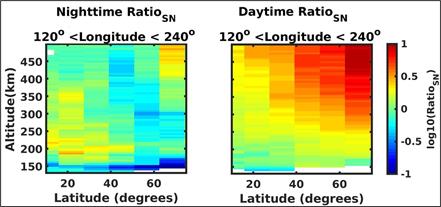Ministry of Science & Technology
Decoding magnetic field-ionosphere relation in Mars can help future space missions
Posted On:
29 AUG 2024 4:25PM by PIB Delhi
Researchers exploring the crustal magnetic field of Mars, found that crustal field effects are much stronger during day-time but almost non-existent during night-time and that daytime crustal field effects remain unaffected by seasons or Sun-Mars distance.
Decoding Mars crustal magnetic field and its effects on the plasma environment near Mars is important to understand the magnetic shielding that has direct implications towards future robotic/human missions to space.
Mars is a planet which does not possess a global magnetic field. However, Mars has scattered crustal magnetic fields in the southern hemisphere. The crustal fields are located poleward of 30°S latitude and within a longitude region of 120° E to 240° E.
Scientists of Indian Institute of Geomagnetism (IIG), an autonomous institute of Department of Science and Technology who had long explored the Earth’s magnetic field and its plasma environment, expanded their focus areas and forayed into planetary space plasma as well. C Nayak, E Yiğit, B Remya, J Bulusu, S Devanandhan, S Singh and AP Dimri, P Padhye conducted an in-depth investigation into how the weak crustal magnetic field of Mars controls its ionosphere and found that during daytime, the crustal magnetic fields strongly control the ionosphere in the southern hemisphere and the control is generally much stronger as compared to the northern hemisphere. However, during nighttime, the crustal magnetic fields lose their control over the ionosphere and hence the hemispheric asymmetry is lost.
The scientists observed that this day-time control of crustal magnetic fields over its ionosphere is independent of the Sun-Mars distance (seasons). The study was published in the Journal of Geophysical Research: Space Physics.
The study was conducted using nearly 8 years of MAVEN (Mars Atmosphere and Volatile EvolutioN) satellite in situ data, of electron density and magnetic field to investigate how the crustal magnetic fields affect the Martian ionosphere. MAVEN is a NASA satellite orbiting Mars from around 2014.
This study by IIG scientists is a step towards enhancing that knowledge that can help future space missions.
Publication link: https://doi.org/10.1029/2024JA032760

The hemispheric asymmetry in terms of variation of Ratio of southern hemisphere (SH) to northern hemispheric (NH) electron density (ne) as a function of latitude and altitude. It represents the ratio of ne in a SH latitude to that in a NH latitude. The left and right panels represent night- and dayside conditions. The color codes shows the ratio in log10 scale, in each 5 km altitude by 10° latitude bin. The white spaces represent data gap.
***
KSY/PSM
(Release ID: 2049766)
Visitor Counter : 1694